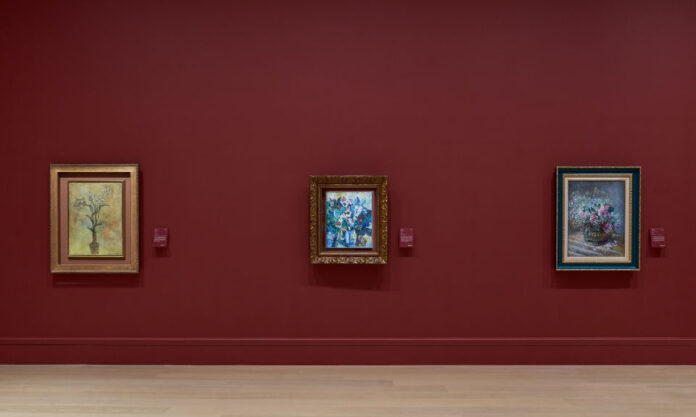Truly not often do you get to upstage Andy Warhol. And with an exhibition about flowers of all things. For there are very few exhibitions, if any, of floral still lifes on a scale that match that now on display in Nanjing.
Those behind, “Nothing Still About Still Lifes: Three Centuries of Floral Compositions”, now on in the Deji Art Museum have put in to it what they call, “10 years of systematic acquisition”. And then put it all together in such a way and with an attention to detail that suggests a lot longer was taken to do so. But this is China. And we move fast. A lot of people have also been very hard at work. It shows too.
Curated by by Dr. Joachim Pissarro, Professor Emeritus at Hunter College of the City University of New York, herein over one hundred works of floral compositions by both Chinese and Western masters. That means San Yu, Wu Dayu, Zao Wou-Ki, Pablo Picasso, Damien Hirst, the aforementioned Mr. Warhol, and star of the show, Claude Monet.
But before we get to all that, let’s be honest; floral still life sounds a bit dull. And that’s why no one bothers. But Deji has breathed new life into the genre with an approach that is both transcultural and transdisciplinary.
Drawing upon nearly 300 years of Chinese and Western history, the exhibition aims to contextualise changes in artistic style within the narratives of flower species’ circulation through global trade. Thus, this exhibition anchors the artistic production of still lifes within the greater landscape of political, economic, scientific, technological and cultural development that has nurtured rich dialogues between China and the Western world over the centuries.
Through the dialectical relationship between “stillness” and “movement”, the exhibition looks back upon the special significance of floral still lifes in Chinese and Western art history, exploring the vital force within these works that inspires our perception and imagination today.
Such is exemplified by a brief examination of the two of the most prominent Chinese artists whose works are on display.
Wu Dayu brings us “Flower in Vase”, painted sometime in the 1950s. Wu belonged to the first generation of Chinese artists to study abroad in France and was one of the founders of modern Chinese painting, known as the “father of Chinese abstract art”. Wu combined schools of modern Western painting with traditional Chinese painting styles, and still lifes depicting flowers in a vase were a recurring subject matter throughout his entire life. The brushstrokes in “Flower in Vase” are both pure and expressive, blurring the border between realism and abstraction, and this work bears important witness both to the artist’s stylistic shift to abstraction in the 1950s, as well as to the nascent stage of modern Chinese abstract art.
Then there is Zao Wou-ki with “The Lillies” from much the same time. Zao was among the second generation of Chinese artists to study in France. The Lillies, while carrying on the traditional Chinese use of lines, reflect even more his continuation and revival of traditional Chinese bird and flower motifs. It can be considered a work representative both of Zao’s harmonious blend of Chinese and Western aesthetics, and his combination of traditional elements and modernism.
Hence, if there’s anything this exhibition teaches us, it’s that in art there are no absolutes. There is no Chinese art, or French art, or Renaissance, or Impressionism. There is only a blurring of the lines in between. And that’s what makes this expansive exhibition all the more compelling.
Deji, terribly terribly proud of this opus (and rightfully so), is also surprisingly humble. And as a result, cagey when it comes to money. And The Nanjinger supports that sentiment. But there is obviously ridiculous value attached to many of the pieces within the exhibition. Star of the show, Claude Monet’s “Fleurs dans un pot”, for example, was sold at Sothebys in New York in 2021 for US$10,375,200. To whom we don’t know…
One of only four still lifes made by Monet in 1878, this is the work that shows Monet relying upon colour and light effects to depict the dynamic life force of flowers.
And it doesn’t stop there. Also housed within, another Monet, “L’Escalier”, worth a bit less, is to be found in the exhibition’s sophomore chapter, “Avant-Gardening”, where Monet portrays the results of him moving to the small village of Vétheuil that same year.
And as for that Andy Warhol, “Flowers” from 1964 is significant for it becoming the symbol of Warhol’s pivotal shift towards nature-based themes. Indeed, each spring, critics are reminded of the influence that this element of Warhol’s cannon of work continues to have on the art world, long after it was fashionable in the “flower power” era.
“Nothing Still About Still Lifes: Three Centuries of Floral Compositions”, runs indefinitely in the Deji Art Museum on 8F of Deja Plaza Phase II. Admission is ¥180.









